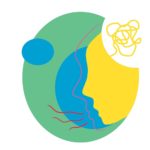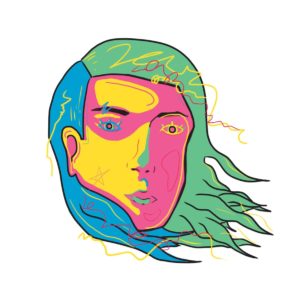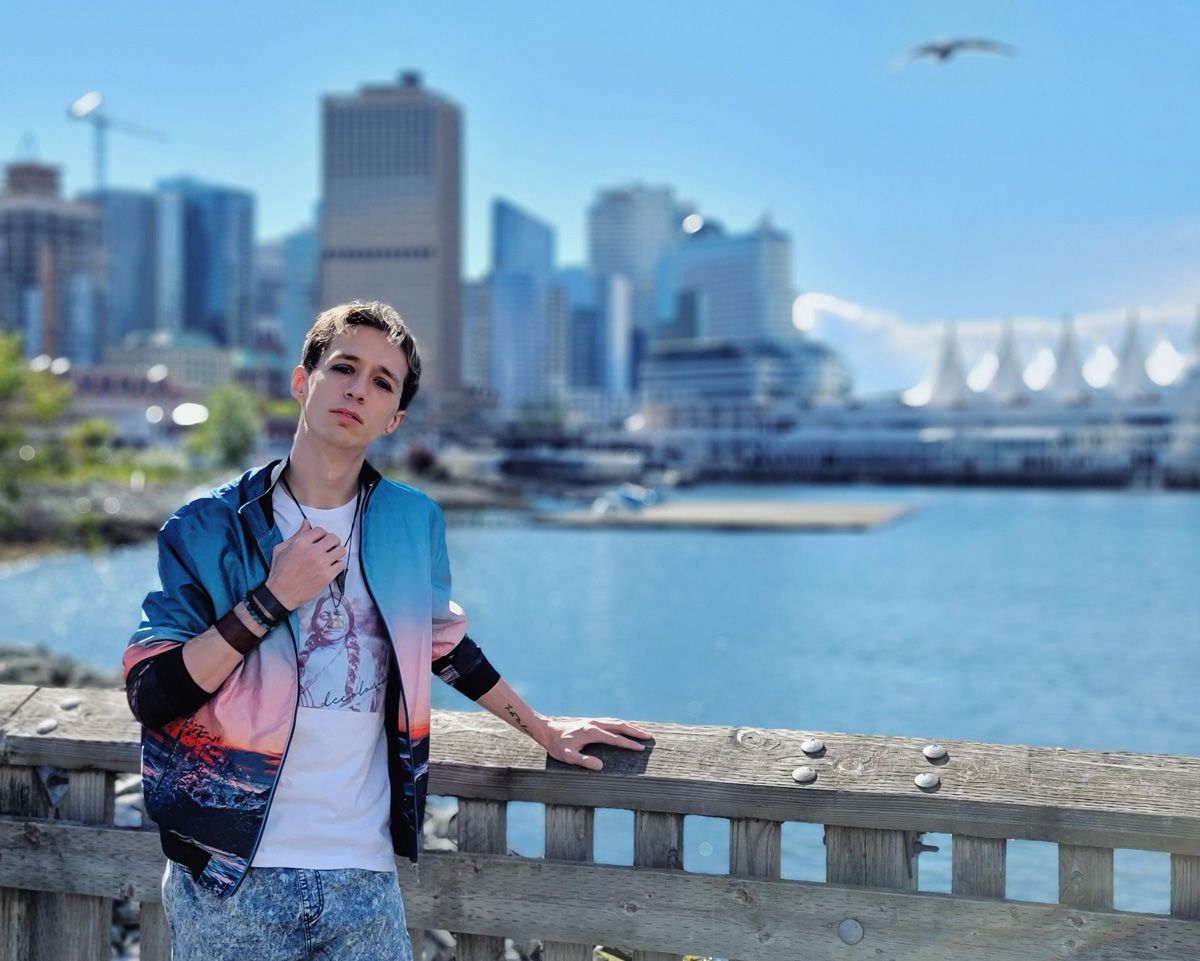Tawahum Bige [he/they] is, in their words, “the whole gamut”: poet, performer, land defender, rapper, musician, and writer, as well as an uncle and a little brother.
Bige, a Two-Spirit, nonbinary Łutsel K’e Dene and Plains Cree writer, began their poetry career while studying at Kwantlen University. They remember being struck by the power of imagery while hearing spoken word poet Hannah Johnson perform at Slamming the Binary: “They had this work about mermaids and their experience with gender, and pushing against it, but what I remember most was just being pulled into this underwater world they were creating […] I’m enamoured. […] I’m just in this world and I want to know more about how to do that myself. That was my biggest question coming out of it, was not just ‘that was amazing’ but ‘how would I do something like that?’”
When Bige started taking creative writing classes a year later, they found that the classes helped them engage in a process of healing, and that the tools they learned in their poetry classes helped them “honour [their] story better.” After working with professors such as Aislinn Hunter, Nicola Harwood,Billeh Nickerson, Jen Currin and Kathy Stonehouse, Bige had the opportunity in 2017 to put together a spoken word theatre piece with the Urban Native Youth association and the Talking Stick Festival. The Talking Stick Festival opened countless opportunities for Bige, who has since facilitated the Telling It Bent mentorship with Frank Theatre, was the poet-in-residence at Burnsview Secondary, and has facilitated workshops and worked one-on-one to mentor poets just entering the competitive scene.
In their own work, Bige is grateful for the support of members of the community, including Kimmortal, Jillian Christmas, Sho Wiley, Mitcholos Touchieand Janet Rogers, and has been influenced by internationally known poets such as Saul Williams, Kate Tempest and Julian Randall. Their work has also been shaped by the lyrics of Zack de la Rocha: “Nothing’s ever not an image,” Bige says of Delarocka’s lyrics, “it’s revolutionary and full of resistance.”

Resistance, for Bige, is at the heart of poetry. “I’m very critical of contemporary CanLit and even just the poetic movements that have come out of Europe […] I feel like they are disconnected from a lot of resistance and speaking truth to power, and that is one of the biggest roles of the poet” Bige explains. “It’s one of the biggest reasons that [poetry is] not the most affluent venture to get involved with, because we do speak truth to power, and that’s scary for governments and that’s scary for any power structure, really.”
Bige understands that one cannot separate their lived experience from the lens through which they view the world. As someone involved with land protection work, Bige’s activism and their role in political movements naturally fits into their poetry. “All poetry is political,” they affirm, “but we come to art from whatever realm it’s in; our lived experience, that place we are in, and so for me it is tightly tied to [politics].” Bige understands the intersections of identity, perspective and art.
“For Indigenous poets […] we have been speaking poetry since time immemorial,” Bige explains, “We’ve done this funny thing in colonial society of separating arts from everything else, and even separating the arts from each other, but our poetics have been tightly tied to storytelling for so, so long.”
“To be a poet is to be a great many things,” Bige continues, “In ancient senses — both a lawmaker or a critic of law, or a lawyer — is to be a poet. To be somebody who is telling the stories that guide the next generation, is to be a poet. To be somebody who is at the front of a war band, inspiring folks to continue marching, is a poet.” Every part of Bige’s life and identity is met and held in their own role as a poet.

“I love speaking not just to an audience, but to what I feel like is my audience,” they share, “When it’s folks who are involved in land protection work, specifically Indigenous land defenders, when I get to talk to us, when I get to speak with us, it feels like a conversation.” The relationship between Bige and their audience is alive; as each performance changes slightly, and each audience changes, there is an immediate, real and intimate relationship between the poet and the community. Their understanding of the relationship between poet and audience has been shaped by Sam McKegney’s article “Writer-Reader Reciprocity and the Pursuit of Alliance in Indigenous Poetry” and its exploration of the fluid contexts of an audience and writer. Whether on the slam stage, in a classroom, at a university or on the frontlines, Bige’s poetry is constantly fluid. The way a story is told through poetry, and the lives of every person present, to watch its unfolding becomes part of the performance itself: “Disruptions? There are none,” Bige says, “Truly, in a show, it all becomes part of the performance anyway.”

Bige comments that students are not exposed to contemporary poetry in high school and traditional curriculums, but that there is an incomparable value of reading and learning from works that are being created in our current world, works that reflect back to us. “The beauty of contemporary poetry is that we speak to this world that’s immediately around us,” Bige notes. “And if I’m speaking to the world that’s immediately around me, then I’m re-speaking that into the microphone when we’re outside the gates of Trans Mountain, or we’re out marching and protesting, these elements are right there.” The world is changed by the poetry that is spoken about it, and to it, just as words shift and transform depending on their context and their audience. Bige recalls recently performing at a court support, and being able to interact directly with the environment around them: “There was a powwow drum there and I was talking about drummers, there was a sacred fire there and I was talking about stoking a sacred fire — these elements were right there and I could point them — they were part of the work as it was already created.”
“I love critiquing the cops in front of the cops,” they add. Bige finds rage to be an effective writing tool, reflecting that part of envisioning alternative futures for the world is “speaking truth to what’s wrong without needing to know what the solution is.” Reflecting on the experience of performing to hostile audiences, Bige explains that they cannot expect others to change their behaviour if they are unwilling to admit their own complicity in harmful systems. “Nonetheless, I’m not interested in making sure I never alienate my audience,” they add, “There are people who are against us, and they are going to be against us, and I have no interest in making them feel good in that space.” Bige explains that people need to be confronted by reality, discomfort and their own complicity wherever they walk, “and if we can do that in our art? Beautiful.”
Bige orients their work, energy and poetry towards those who “are looking to drink of it.” It is them, Bige says, who deserve the attention. As they work to confront their audience, Bige is intentional about the spaces they are creating: “If we can create a space where other folks feel at least a little bit safer, even if that isn’t the case – that we are safe – I love providing moments of refuge and respite. If I can do that in my poetry, that’s often the place that I want to locate myself.”
“It’s ceremony,” Bige says of spoken word poetry. “You go into a real deep place of ceremony very quickly with the arts, and with poetry, with performance, in three minutes – or less if it’s a slam stage –I’m able to tell you some deep shit about my life story, and that is nothing if not ceremony [.…] Ceremony is all about maintaining relationships, if not building them. And we have that ceremony accessible to us at any time.” Bige and Kimmortal recently did an online performance that will be released shortly with the Evergreen Cultural Center. They have an upcoming a pre-recorded show with fellow performers such as Julian Christmas and Tin Lorica. Their first book, with Nightwood editions, is coming out in 2022, and they are already concluding edits for their second book. An EP is already being recorded, and is likely to be released by the end of the year.
You can find Bige on Instagram at @tawahum.


